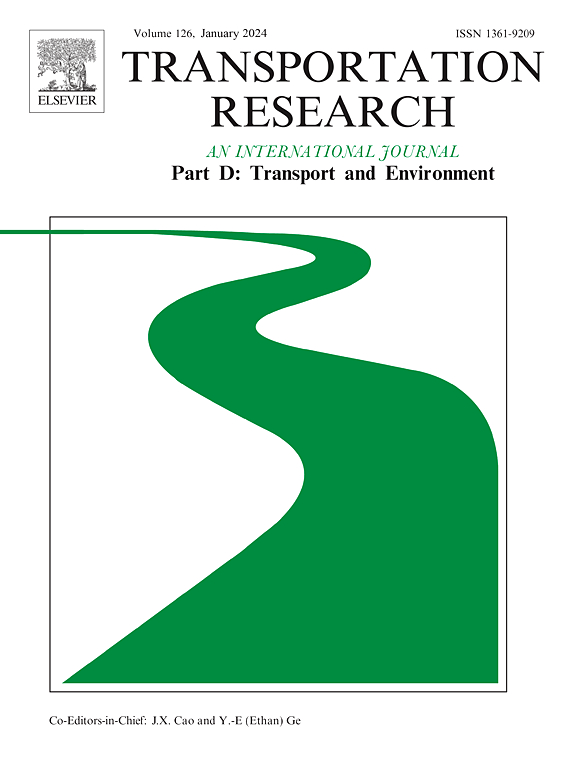高速公路合流区重型车辆能量影响研究
IF 7.7
1区 工程技术
Q1 ENVIRONMENTAL STUDIES
Transportation Research Part D-transport and Environment
Pub Date : 2025-10-18
DOI:10.1016/j.trd.2025.105044
引用次数: 0
摘要
重型车辆对高速公路合流区域的负面影响加剧了车辆能耗和污染物排放。基于中国高速公路合流区实际车辆运行数据,分析重型车辆影响下驾驶员行为差异,建立驾驶员行为模型。通过引入驾驶员异质性因素和重型车辆影响因素,改进了合并车辆变道博弈收益函数。提出了一种适合中国道路条件的群体车辆引导与分配优化模型,以优化交通效率和最小化能耗为目标。仿真结果表明,车路协调有效地缓解了重型车辆在合并区域的不利影响,显著提高了交通效率,减少了频繁的加减速。结果表明,合并段平均速度提高了15-22%,平均能耗降低了7.3-13.1%,污染物排放量降低了4.1-16.4%。本文章由计算机程序翻译,如有差异,请以英文原文为准。
Energy impacts of heavy vehicles in cooperative highway merging areas
The negative impacts of heavy vehicles in highway merging areas exacerbate vehicle energy consumption and pollutant emissions. Based on real-world vehicle operation data collected from merging areas on Chinese expressways, this paper analyzes the differences in driver behavior under the influence of heavy vehicles and establishes a driver behavior model. By introducing driver heterogeneity factors and heavy vehicle influence factors, the lane-changing game payoff function of merging vehicles is improved. A group vehicle guidance and allocation optimization model tailored to China’s road conditions is proposed, aiming to optimize traffic efficiency and minimize energy consumption. Simulation results demonstrate that vehicle–road coordination effectively mitigates the adverse effects of heavy vehicles in merging areas, significantly improving traffic efficiency and reducing frequent acceleration and deceleration. The results show an approximately 15–22% increase in average speed, a 7.3–13.1% reduction in average energy consumption, and a 4.1–16.4% decrease in pollutant emissions within the merging section.
求助全文
通过发布文献求助,成功后即可免费获取论文全文。
去求助
来源期刊
CiteScore
14.40
自引率
9.20%
发文量
314
审稿时长
39 days
期刊介绍:
Transportation Research Part D: Transport and Environment focuses on original research exploring the environmental impacts of transportation, policy responses to these impacts, and their implications for transportation system design, planning, and management. The journal comprehensively covers the interaction between transportation and the environment, ranging from local effects on specific geographical areas to global implications such as natural resource depletion and atmospheric pollution.
We welcome research papers across all transportation modes, including maritime, air, and land transportation, assessing their environmental impacts broadly. Papers addressing both mobile aspects and transportation infrastructure are considered. The journal prioritizes empirical findings and policy responses of regulatory, planning, technical, or fiscal nature. Articles are policy-driven, accessible, and applicable to readers from diverse disciplines, emphasizing relevance and practicality. We encourage interdisciplinary submissions and welcome contributions from economically developing and advanced countries alike, reflecting our international orientation.

 求助内容:
求助内容: 应助结果提醒方式:
应助结果提醒方式:


